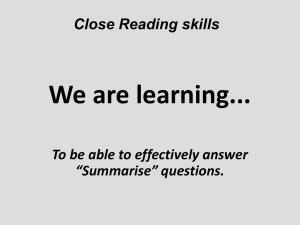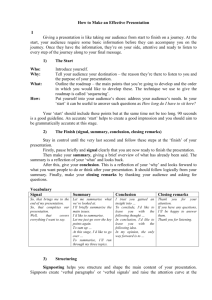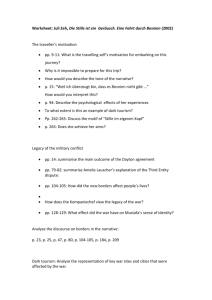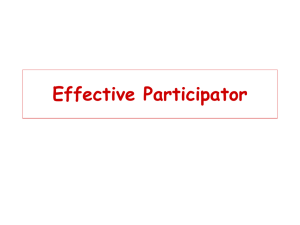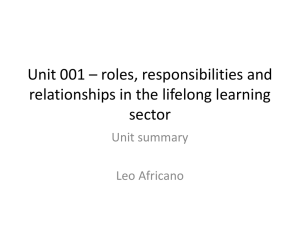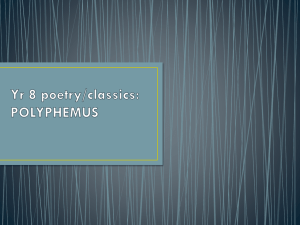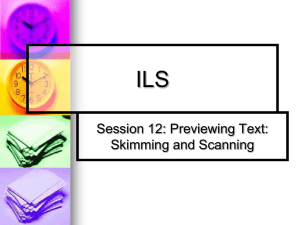WRITING SKILLS FOR POLICY MAKERS AND
advertisement
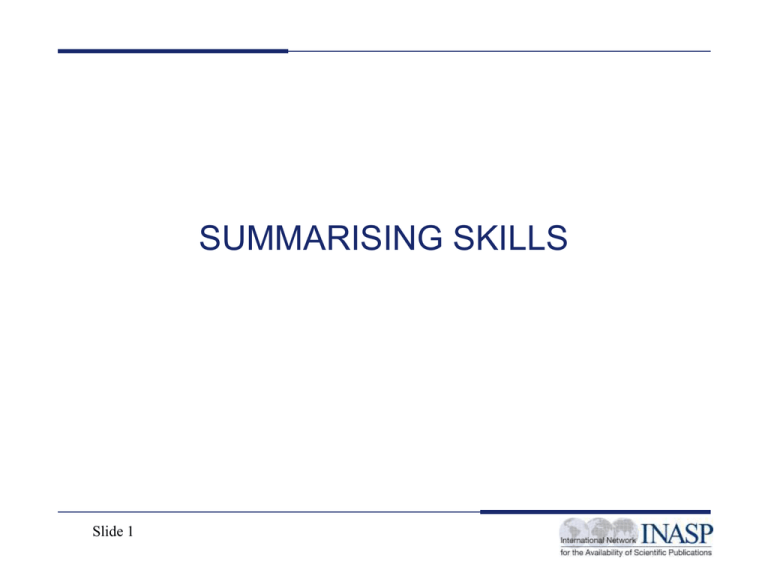
SUMMARISING SKILLS Slide 1 Objectives • to improve summarising and outlining techniques, essential first steps in the research and writing of policy briefs Slide 2 Summarising Skills • What is the definition of “summary”? • Brainstorm: What are some reasons why you might need to summarise? What are some situations where summarising is a useful skill to have? What do you find challenging about summarising? Slide 3 Practise summarising… (Sentence #1 on your handouts) Summarise in 2 sentences or less. More than 30% of all greenhouse gas emissions come from the land-use, land-use change and forestry sector, with 18-20% estimated to result from deforestation and forest degradation, and between 10-12 % from agriculture (Smith et. al 2007). About 70% of emissions from agriculture could be mitigated through activities in developing countries but so far only the forestry sector has featured in UNFCCC mitigation strategies and mechanisms. Agriculture is inextricably connected to deforestation and forest degradation in many countries, especially in Africa. Reducing emissions from agriculture and storing carbon in agricultural lands can increase the effectiveness of global efforts against climate change globally. From http://www.worldagroforestry.org/downloads/publications/PDFS/BR09047.PDF Slide 4 The three pillars of summarising: 1. Selecting main ideas, regrouping and recombining them 2. Generalizing and categorising ideas from your understanding of the reading 3. Deleting unnecessary details that are not important to the overall meaning of the reading – always the most difficult! Slide 5 How to summarise 1.Skim article. 2.Read it in-depth, (taking notes) 3.Plan 4.Write Slide 6 Step 1: Skimming When skimming, look for: 1.The title and subtitles 2.The abstract, if there is one 3.Captions to illustrations/diagrammes 4.Structural hints: layout, graphs, charts 5.Keywords: words in bold, italics, highlighted, or just used frequently 6.Sequential markers: first, next, then, in addition, in the section which follows, after this, finally, lastly, moreover, in conclusion, thus, accordingly… Slide 7 Step 2: In-depth reading and taking notes Slide 8 Step 3: Planning • Different kinds of writing plans: – – – – – Outline/Bullet points Mind map Network/hierarchical diagram Compare/contrast table Flow chart – NB. These planning strategies can be used to direct all kinds of writing. Slide 9 How to plan your summary: outline/bullet points HIV/AIDS IN AFRICA Introduction -Overview of topic Science -HIV virus -Pathogenesis of AIDS History -Early reports of AIDS -Evolution of HIV from SIV Current Situation -Prevalence -by country -high-risk groups Treatment and Prevention Strategies -Barrier methods- condoms- education -Anti-retroviral -Vaccine? Conclusion Slide 10 Try making your own outline of one of the following topics: •Tourism in your country •The World Cup •Or a subject of your choice! How to plan your summary: mind map Try making your own mind map of one of the following topics: •Climate change •Popular Music •Or a subject of your choice! Slide 11 How to plan your summary: tree diagram Try making your own tree diagram of one of the following topics: •The organisation that you work in •Animals •Or a subject of your choice! Slide 12 How to plan your summary: compare/contrast table Beyonce Shakira Year born 1981 1977 Country of origin USA Colombia First language English Spanish Height 173cm 157cm Eye colour Brown Brown Slide 13 Try making your own compare/contrast table of one of the following topics: •Fossil fuel versus nuclear energy •You versus your brother/sister •Or a subject of your choice! How to plan your summary: flow charts Try making your own flow chart of one of the following topics: •The legislative process •How to make a cup of tea •Or a subject of your choice! Slide 14 Exercise • Read paragraphs 2 and 3 on handout 1. • Choose one to make a plan of using any of the techniques we have tried: – – – – – Outline/Bullet points Mind map Network/hierarchical diagram Compare/contrast table Flow chart Slide 15 Step 4: Writing • • Now you can start writing based on your plan Remember to follow the five steps of writing: 1. 2. 3. 4. 5. Slide 16 Planning Drafting Revising Editing Proofreading What to do if the reading is very long: • Divide the reading into a number of sections when you are first skimming it and identify the main ideas in each section. You will then need to collect together all the main ideas from each section as a whole to make sure that you represent the reading accurately as a whole. Slide 17 © Kris Anderson Some tips to help you summarise Some tips to help you summarise What to do if the ideas are difficult to understand • The reading may contain ideas that you are not yet familiar with. If so, you can consult a more general reading (such as a textbook for that subject or a specialized dictionary), or talk to an expert. Slide 18 Some tips to help you summarise What to do if the reading is poorly organised and/or written •Problems may arise because the source is unclear to begin with. Talk with an expert or a colleague – don’t just give up on an important source! Slide 19 Some tips to help you summarise • This can happen when you work through the reading sentence by sentence. Refer to the steps mentioned earlier and try to abbreviate the reading. • If your writing too closely resembles the original document, it may be plagiarism, which has legal ramifications. Slide 20 © Kris Anderson What to do if your summary looks very close to the original Review: how to summarise • First, skim the article. • Second, read it in-depth, taking notes on its key points. • Third, plan your summary via: • Spider diagram, tree/hierarchical diagram, flow chart, bullet points, or outline • Cross-check: does your plan match up with your expectations on skimming the article? If not, re-read to make sure you’re not missing something out? • Write the summary based on your plan, making sure that it adheres to your plan. Follow the “Five Steps of Effective Writing”, and use all of the hints above to maintain brevity, clarity, and structure. Slide 21 • • • • This presentation was originally written by Kris Anderson The presentation is licensed under the Creative Commons Attribution-NonCommercial-ShareAlike 3.0 Unported License. You are free to modify and use this presentation for non-commercial purposes providing you retain the attribution of all images and credit INASP. For further information please contact inasp@inasp.info Slide 22
